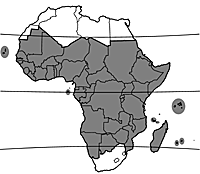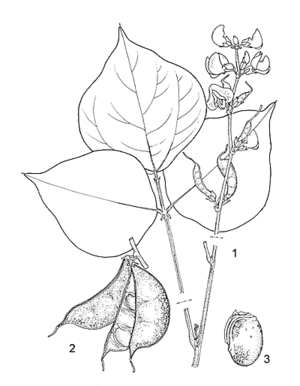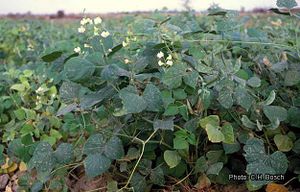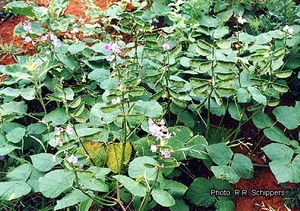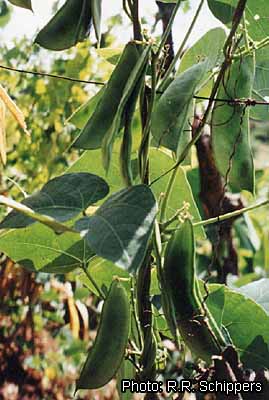Lablab purpureus (PROTA)
Introduction |
| General importance | |
| Geographic coverage Africa | |
| Geographic coverage World | |
| Cereal / pulse | |
| Vegetable | |
| Dye / tannin | |
| Medicinal | |
| Ornamental | |
| Forage / feed | |
| Auxiliary plant | |
| Food security | |
| Climate change | |
Lablab purpureus (L.) Sweet
- Protologue: Hort. brit., ed. 1, 2: 481 (1826).
- Family: Papilionaceae (Leguminosae - Papilionoideae, Fabaceae)
- Chromosome number: 2n = 22, 24
Synonyms
- Dolichos lablab L. (1753),
- Lablab niger Medik. (1787),
- Lablab vulgaris (L.) Savi (1824).
Vernacular names
- Lablab, lablab bean, hyacinth bean, bonavist bean, Indian butter bean, Egyptian bean (En).
- Lablab, pois boucoussou, dolique d’Egypte, pois antaque (Fr).
- Labe-labe, feijão cutelinho, feijão padre, feijão da India, cumandatiá (Po).
- Mfiwi mafuta (Sw).
Origin and geographic distribution
Lablab occurs wild in tropical Africa (including Madagascar) and India. Opinions on the region of first domestication vary. It is often stated that it originates as a crop from India or south-eastern Asia, but a north-eastern African origin is more likely because in large parts of tropical Africa wild and cultivated lablab coexist. In Africa it was dispersed by man probably as early as 800 B.C. and it is now found throughout the continent. It is locally cultivated in most tropical areas of South and Central America, South and South East Asia and Australia.
Uses
The most popular use of lablab in tropical Africa, e.g. in West Africa, Ethiopia and Malawi, is as a vegetable. The young green pods and immature seeds are eaten boiled. Locally, the young leaves are used as a leafy vegetable. Elsewhere, e.g. in northern Nigeria and Kenya , the dry seeds are eaten as a pulse although they require prolonged cooking with several changes of water. In Madagascar and Mauritius lablab is grown on a small scale for both the green and dry seeds. In Ethiopia lablab is grown locally as field crop for the dry seed. In East Africa the ripe seeds are appreciated by the Indian community, because it is popular as pulse in India.
The whole plant is used as a fodder for cattle, either green or as hay or silage. The stems are stronger and more fibrous than the similar cowpea, and animals tend to eat the leaves only and leave the stems. As an annual or short-lived perennial fodder crop it is grown in Australia on a large scale. In Africa it has been grown for the same purpose by large-scale farmers in Kenya and Zimbabwe, where lablab hay is fed to animals to supplement poor quality stover and hay. The dry seeds are also used as fodder, but their acceptability is low. In the 1920s, lablab was promoted in the Gezira scheme (Sudan) as a dual-purpose crop: fodder for livestock and seed for human consumption.
In East Africa the leaves are crushed and sniffed to cure headache. They are used as emmenagogue and to accelerate childbirth and to treat stomach troubles. Green leaves crushed in vinegar have been used to treat snakebites. In Rwanda the leaves are taken in a decoction of a mixture with leaves of other plants in case of heart problems. In DR Congo the leaves are made into an infusion which is drunk to cure tonsillitis. In Senegal the seed is given as a stomachic and antispasmodic and has been used in the treatment of cholera and sunstroke. In India lablab is considered a strong antihypertensive, anticholesterolemic, antispasmodic, digestive, hypoglycaemic and is also used as a cure for diabetes, alcohol intoxication and ear inflammation. In South-East Asia the leaf has been used in the treatment of eczema, gonorrhoea and tumours. In Kenya the seeds either baked or heated are used as a veterinary drug to treat eye problems in sheep and lung problems in cattle, goats and sheep.
Lablab is widely grown for soil improvement and in soil and water conservation programmes, but these uses seem rare in tropical Africa. Because of the ease with which various strains of the plant adapt to different environments, the International Institute of Tropical Agriculture (IITA) has promoted the introduction of Lablab purpureus as cover crop in plantations in the humid savanna areas of Nigeria. It makes a good cover crop in perennial crops such as coffee and coconut. In Australia it is used as a green manure.
In Zanzibar a green dye was obtained from pounded leaves; in the United States it is occasionally grown as an ornamental.
Production and international trade
In tropical Africa lablab is widespread but less popular than some other leguminous vegetables and pulses such as cowpea (Vigna unguiculata (L.) Walp.) or bean (Phaseolus vulgaris L.). The seeds and pods are offered at many local markets, but there are no statistical data available on production or trade.
Properties
The nutritional composition of immature lablab seeds per 100 g edible portion (refuse 7%) is: water 87.9 g, energy 193 kJ (46 kcal), protein 2.1 g, fat 0.2 g, carbohydrate 9.2 g, Ca 50 mg, Mg 40 mg, P 49 mg, Fe 0.7 mg, Zn 0.4 mg, vitamin A 109 IU, thiamin 0.08 mg, riboflavin 0.09 mg, niacin 0.52 mg, folate 62 μg, ascorbic acid 13 mg. The nutritional composition of mature lablab seeds per 100 g edible portion (refuse 0%) is: water 9.4 g, energy 1440 kJ (344 kcal), protein 23.9 g, fat 1.7 g, carbohydrate 60.8 g, Ca 130 mg, Mg 283 mg, P 372 mg, Fe 5.1 mg, Zn 9.3 mg, vitamin A 0 IU, thiamin 1.1 mg, riboflavin 0.15 mg, niacin 1.6 mg, folate 23 μg, ascorbic acid 0 mg (USDA, 2002). The fresh pods of lablab contain per 100 g edible portion: water 87 g, energy 193 kJ (46 kcal), protein 2.9 g, fat 0.45 g, carbohydrate 2.9 g, fibre 1.5 g, Ca 0.6 mg, Mg 37 mg, P 59 mg, Fe 1.2 mg, vitamin A 210 mg, thiamin 0.9 mg, riboflavin 0.08 mg, niacin 0.6 mg, ascorbic acid 11 mg (Rubatzky, V.E. & Yamaguchi, M., 1997).
The dry seeds have a high content of toxic cyanogenic glucosides and trypsine. These toxic compounds are broken down by heat. The content of crude protein in the dry matter of the whole plant and in the leaves is 10–22% and 14.5–38.5%, respectively. As the lower values refer to aged plant material this is a clear indication that lablab can provide a valuable addition to a protein-poor diet of cattle. The leaves are free of tannins.
The seeds contain the flavonoids kievitone and genistein, which play a role in the prevention and treatment of some forms of cancer. Genistein (4’,5’,7-trihydroxyisoflavone) inhibits capillary proliferation in tumours; it also plays a role in the relief of menopause symptoms by binding to the same receptors as human oestrogen. In the plant the phytoalexin kievitone (2’,4’,5,7-tetrahydroxy-8-isopentenylisoflavanone) has been shown to provide protection against fungal attack, e.g. by Aphanomyces root rot. Antinutritional factors such as haemagglutinins, tannins, phytate and trypsin inhibitors have been reported for the seed. The crushed seed appears not very palatable to livestock, possibly due to the presence of cyanogenic glucosides. Tyrosinase, found in the seeds, lowers blood pressure. In seed of wild lablab high levels of chemicals such as vicilins, α-amylase inhibitors and lectins have been found in quantities that may impart resistance to the bruchid Callosobruchus maculatus.
Adulterations and substitutes
The pods and immature seeds of Lablab purpureus in dishes can be replaced by several other leguminous vegetables, e.g. Phaseolus vulgaris L., Vigna unguiculata (L.) Walp. and Pisum sativum L., all considered more palatable than lablab. Dry lablab seeds used as pulses can be replaced by many pulse species.
Description
- Climbing or bushy perennial herb, often grown as an annual; taproot well developed, with many lateral roots; stem up to 6 m long, in cultivated plants often erect, pubescent or glabrous.
- Leaves alternate, 3-foliolate; stipules ovate, c. 5 mm long, reflexed, persistent; petiole 1–18 cm long, rachis up to 4.5 cm long; stipels lanceolate; leaflets ovate-triangular, up to 15 cm × 14 cm, apex acuminate, entire, pubescent to glabrous.
- Inflorescence an axillary, many-flowered false raceme; peduncle 2–40 cm long, rachis up to 25 cm long; bracts ovate-lanceolate, c. 4 mm long, deciduous.
- Flowers bisexual, papilionaceous; pedicel short; calyx with tube 3–4 mm long, 2-lipped, upper 2 lobes joined, lower 3 lobes up to 4 mm long; corolla white to deep purple, standard up to 1.5 cm long, keel beaked; stamens 10, 9 fused and 1 free; ovary superior, c. 1 cm long, 1-celled, style laterally flattened, abruptly upturned, stigma headlike.
- Fruit an oblong-falcate to oblong-linear pod 4–15 cm × 1–4 cm, usually compressed, 2–6-seeded.
- Seeds ovoid to oblong, compressed, white or red to black; hilum linear; aril whitish.
- Seedling with epigeal germination.
Other botanical information
Lablab comprises a single species and is closely related to Dolichos, which has a more or less rounded style in cross section, a gradually curved keel and short seed hilum. Three subspecies of Lablab purpureus have been described. Subsp. uncinatus Verdc. comprises wild plants occasionally cultivated in East Africa and then of clearly local origin; it has comparatively small fruits, c. 4 cm × 1.5 cm. Subsp. bengalensis (Jacq.) Verdc. is a short-lived, perennial, twining herb grown as an annual in cultivation; it has distinctive tender fruits up to 15 cm × 2.5 cm and is common throughout the tropical and subtropical regions of Africa, Asia and the Americas. Subsp. purpureus is a long-lived, semi-erect bushy perennial, but usually grown as annual, showing little or no tendency to climb; the fruits are relatively short, up to 10 cm × 4 cm, and the plant is flushed with purple in all its parts and has a peculiar strong, unpleasant smell; it is grown in Asia as a field crop for the ripe seeds and fodder.
Growth and development
Short-day cultivars of lablab start flowering as early as 42 days after sowing depending on sowing date. Flowers are mainly cross-pollinated, but the degree of self-pollination is considerable. Improved cultivars start fruiting 60–65 days after sowing and continue for 90–120 days. Mature seeds are harvested 150–210(–300) days after sowing depending on cultivar and time of sowing. Seeds shatter easily. In cooler climates the plant dies at the end of the growing season, but in the tropics perennial types may persist for 2–3 years.
Lablab roots easily form N-fixing nodules with lablab- or cowpea-type Rhizobium, common in tropical soils worldwide. Nitrogen fixation of 180–215 kg/ha has been recorded in 150 days in Australia and 107 days in Ethiopia. In India, inoculation with Rhizobium is advised for localities where lablab has not been grown recently, but in Ethiopia inoculation did not increase the amount of nitrogen fixed.
Ecology
In the wild lablab occurs in grassland, bushland and gallery forest, up to 2400 m altitude. It is normally a short-day plant, but day-neutral and long-day cultivars exist. Lablab prefers lower elevations but it can thrive well up to 2100 m altitude. The temperature requirement for good growth ranges from 22–35°C. Light frost damages the leaves but does not kill the plants. It grows rainfed in areas with a rainfall of 750–2500 mm/year. Once established (2–3 months after sowing) lablab is quite drought tolerant. It has a deep root system penetrating to water sources more than 2 m below the soil surface. This permits lablab to grow luxuriously into the dry season. Lablab grows in a variety of soils ranging from deep sands to heavy clays and from acid to alkaline (pH 4.4–7.8) as well as in aluminous soil. It does not tolerate standing brackish water or waterlogging. Provided drainage is good, lablab is tolerant of poor soil texture.
Propagation and planting
Lablab is propagated by seed, either broadcast or sown in rows. Germination takes about 5 days. Germination is faster when seeds are soaked in water for 4 hours. The weight of 1000 seeds is 250–500 g, in wild plants 50–120 g. Some 3–4 seeds per hole are sown on flat terrain or on ridges, at a depth of 2–5 cm and at a spacing of 30–45 cm between holes and 60–100 cm between rows. The seed rate required is 30–50 kg/ha; in Australia 15–30 kg/ha is recommended. When grown as a field crop, lablab can be established by broadcasting into roughly ploughed land if the seed is covered to some extent. However, it is usually sown in rows.
Management
Climbing cultivars and wild types are widely grown along fences and hedges or supported by sticks or trellises of 2 m tall. Bushy cultivars are commonly grown as a field crop, mostly intercropped with a cereal, e.g. sorghum, millet or maize, or with cotton or castor. It may be relay planted to reduce competition with the cereal. It is also grown in rotation with sorghum and cotton to improve the soil fertility. Lablab suppresses weed growth but some weeding during the early stages of growth is recommended. In India garden cultivars are well fertilized with organic manure or NPK fertilizer. In field cultivation as pulse on fertile soils, fertilizer is rarely applied, but when grown on poor sandy soils 250–500 kg/ha superphosphate and some potash is advised. Although deep rooted and drought resistant when well established, lablab as a garden crop needs regular irrigation in the dry season.
In Australia lablab grown as an annual fodder crop can be grazed when it has formed a full canopy and reached a height of 0.5 m, generally 8–12 weeks after germination. It can be grazed up to 3 times.
Diseases and pests
In general, lablab suffers from the same pests and diseases as cowpea but it is more resistant. Anthracnose (Colletotrichum lindemuthianum) can cause serious crop losses; spraying with zineb or captan may give reasonable control. Leaf spot (Cercospora dolichi) and powdery mildew (Leveillula taurica var. macrospora) may also be troublesome and are controlled by spraying with fungicides. Xanthomonas phaseoli can cause severe defoliation in humid weather. Sclerotium rolfsii may cause rotting of the stem bases. In Asia several pests have been recorded on lablab: pod boring larvae (e.g. Adisura atkinsoni) are the most serious pest, which can be controlled by spraying with Bacillus thuringiensis preparations; in addition, army worm (Heliothis armigera), plume moth (Exelastis atomosa) and spotted podborer (Maruca testulalis) are of economic importance. Insect infestation during storage may be caused by bruchid beetles (Callosobruchus spp.), which also attack the crop in the field. Harvesting individual pods as soon as the seed is ripe reduces bruchid infestation. Lablab roots are attacked by several nematodes. There is lack of information on diseases and pests of lablab in Africa.
Harvesting
Young immature pods are picked as soon as they have reached a reasonable size, at intervals of 3–4 days. In many cultivars pods ripen in succession on the stem. Harvesting of dry seeds may start 12–15 weeks after planting in early cultivars, and continue until after 45 weeks in late ones. For cultivars with non-shattering pods collection of dry pods can be done after drying on mother plants, but in cultivars with shattering pods they should be collected in several rounds when in the green-ripe stage and then dried on a platform. When senescence starts, the entire plant is sometimes cut close to the ground with a sickle and left to dry for a few days before threshing. For fodder lablab is usually harvested at flowering or in the early green fruit stage.
Yield
The average yield of green pods varies from 2500–5000 kg/ha, while the average yield of seed is about 450 kg/ha if grown as an intercrop and up to 1500 kg/ha in sole cropping. In India the cultivar ‘Co.9’ yields on average 7500 kg/ha of immature pods in 120 days; cultivar ‘Highworth’ produces over 1.5 t dry seed/ha in commercial exploitation, but in trials yields of over 4 t/ha have been recorded. For ‘Highworth’ fodder yields of 25–40 t/ha with a total dry matter of 5–11 t/ha have been recorded. In Zimbabwe production of forage amounted to over 9 t of dry matter per ha at 16 weeks after sowing.
Handling after harvest
Green pods are cleaned and graded for size, before being packed in baskets for the market. Storage of green pods at 2–4°C and a relative humidity of 85–90% extend the shelf life to a maximum of 21 days, and of shelled fresh seeds of up to 7 days. In South-East Asia mature seeds are stored in earthenware or metallic containers after being dried and cleaned, and they are covered with a 5 cm protective layer of sand. Reduction of the moisture content to below 10% is effective against bruchid infestation. Seed stored under commercial storage conditions maintains its viability for 3–4 years. There is evidence that white-seeded cultivars lose their viability faster than dark-seeded ones. For animal nutrition lablab can be stored as hay or silage.
Genetic resources
More than 250 lines, both indigenous and exotic, are maintained in India at the University of Agricultural Sciences, Bangalore and small collections at Tamil Nadu Agricultural University, Coimbatore and at the Indian Institute of Horticultural Research, Bangalore. The National Genebank of Kenya, Magugu holds over 340 accessions. A germplasm collection is maintained at the legume unit of the International Institute of Tropical Agriculture (IITA), Ibadan, Nigeria, for evaluation and distribution to farmers to be used as a cover crop. The genetic diversity has been studied using DNA markers. Genetic variation in cultivated lablab appeared to be small, cultivars from India being the most divergent. There was a large difference between cultivated and wild genotypes. Wild plants from Zambia and Zimbabwe were closely related but highly divergent from plants from Uganda. Wild material from West Africa, Namibia, Botswana and Madagascar appears to be lacking in collections. A study on diversity in morphological characteristics in accessions from the collections of CSIRO (Australia) and ILRI (Ethiopia) revealed that in Ethiopia cultivated lablab is very similar in a number of characteristics to the wild African plants and different from the cultivated lablab elsewhere. Based on this study, a core collection of 47 genotypes has been selected for breeding purposes. In Australia and New Zealand, only fodder types are maintained.
Breeding
Selection in lablab has been undertaken in Mauritius for use as a vegetable. Most of the improvement work on the climbing vegetable types and bush pulse types is concentrated in India, where several cultivars (e.g. ‘Co.9’ and ‘Co.12’) have been released. Desired qualities in improved cultivars are short duration, daylength neutrality, uniform maturity and disease resistance. Elsewhere, breeding is mainly targeted at use as a fodder crop. Bushy, short-duration, day-neutral, disease-resistant cultivars have been obtained. Cultivar ‘Highworth’ is a popular pulse and forage cultivar from Queensland, Australia. It is quick maturing and yields well in widely differing environments; its pods are non-shattering, mature at much the same time, and grow above the foliage at the top of the stems so that harvesting is made easy. The cultivars ‘Rongai’ and ‘Highworth’ are selections from landrace material and have been widely grown in the tropics. The landrace from which ‘Rongai’ was selected is late flowering and was found in Rongai, Kenya close to the equator. After ‘Rongai’ was imported in South Africa as a fodder crop for large commercial farms, small-scale farmers started growing it as well for use as a vegetable and pulse crop. These farmers made further selections based on seed colour. As this cultivar is daylength sensitive, it is late flowering, leaf production is high but seed production is late and in southern Africa threatened by early frost. The most recently released cultivar in Australia ‘Endurance’ is a result of crosses between ‘Rongai’ and a perennial wild parent. A white-seeded cultivar, ‘Koala’, has been released in Australia.
Prospects
Lablab purpureus is a multipurpose species, useful as a vegetable, pulse, fodder, cover crop and green manure, but with different cultivars for these main uses. As a tough plant it is interesting for home gardens but less for market production, where more palatable and productive leguminous crops are available, e.g. Phaseolus vulgaris, Vigna unguiculata and Phaseolus lunatus L. Breeding of vegetable type lablab cultivars should therefore concentrate on palatability, mainly by selecting on tenderness of the seedcoat.
As a pulse and forage crop it does not enjoy much popularity among farmers in tropical Africa, but it is promising because its yields are higher than those of cowpea and its spectrum of adaptability to differing ecological conditions is wider than for any other leguminous plant. It merits attention for breeding and agronomy research. Breeding could pay high rewards if the enormous variation is utilized.
Major references
- Burkill, H.M., 1995. The useful plants of West Tropical Africa. 2nd Edition. Volume 3, Families J–L. Royal Botanic Gardens, Kew, Richmond, United Kingdom. 857 pp.
- Joshi, S.R., Sreekantaradhya, K.B., Shambulingappa, G., Shivashankar, G. & Jagannath, D.P., 1995. Genetic variation in pod characteristics in field bean (Lablab purpureus) and its relation to classification as subspecies. Crop Research (Hissar) 9(1): 78–80.
- Mackinder, B., Pasquet, R., Polhill, R. & Verdcourt, B., 2001. Leguminosae (Papilionoideae: Phaseoleae). In: Pope, G.V. & Polhill, R.M. (Editors). Flora Zambesiaca. Volume 3, part 5. Royal Botanic Gardens, Kew, Richmond, United Kingdom. 261 pp.
- Murphy, A.M. & Colucci, P.E., 1999. A tropical forage solution to poor quality ruminant diets: a review of Lablab purpureus. Livestock Research for Rural Development 11(2). [Internet] http://www.cipav.org.co/lrrd. April 2004.
- National Academy of Sciences, 1979. Tropical legumes: resources for the future. National Academy of Sciences, Washington, D.C., United States. 331 pp.
- Pengelly, B.C. & Maass, B.L., 2001. Lablab purpureus (L.) Sweet - diversity, potential use and determination of a core collection of this multi-purpose tropical legume. Genetic Resources and Crop Evolution 48(3): 261–272.
- Shivashankar, G. & Kulkarni, R.S., 1989. Lablab purpureus L. (Sweet). In: van der Maesen, L.J.G. & Somaatmadja, S. (Editors). Plant Resources of South-East Asia No 1. Pulses. Pudoc, Wageningen, Netherlands. pp. 48–50.
- Skerman, P.J., 1977. Tropical forage legumes. FAO Plant Production and Protection Series No 1. Rome, Italy. 609 pp.
- USDA, 2002. USDA nutrient database for standard reference, release 15. [Internet] U.S. Department of Agriculture, Beltsville Human Nutrition Research Center, Beltsville Md, United States. http://www.nal.usda.gov/fnic/foodcomp. June 2003.
- Wilding, J.H., 1974. Highworth, new lablab cultivars. Queensland Agricultural Journal 100: 281–284.
Other references
- Allen, O.N. & Hamatova, E., 1973. IBP World Catalogue of Rhizobium Collections. International Biological Programme, London, United Kingdom. 282 pp.
- Biju, M.G., Prasanna, K.P. & Rajan, S., 2001. Genetic divergence in hyacinth bean. Vegetable Science 28(2): 163–164.
- Chifundera, K., 2001. Contribution to the inventory of medicinal plants from the Bushi area, South Kivu Province, Democratic Republic of Congo. Fitoterapia 72: 351–368.
- du Puy, D.J., Labat, J.N., Rabevohitra, R., Villiers, J.-F., Bosser, J. & Moat, J., 2002. The Leguminosae of Madagascar. Royal Botanic Gardens, Kew, Richmond, United Kingdom. 750 pp.
- Duke, J.A., 1981. Handbook of legumes of world economic importance. Plenum Press, New York, United States, and London, United Kingdom. 345 pp.
- Fischler, M. & Wortmann, C.S., 1999. Green manures for maize-bean systems in eastern Uganda: Agronomic performance and farmers’ perceptions. Agroforestry Systems 47(1/3): 123–138.
- Haque, I. & Lupwayi, N.Z., 2000. Nitrogen fixation by annual forage legumes and its contribution to succeeding wheat in the Ethiopian Highlands. Journal of Plant Nutrition 23(7): 963–977.
- Ignacimuthu, S., Janarthanan, S. & Balachandran, B., 2000. Chemical basis of resistance in pulses to Callosobruchus maculatus (F.) (Coleoptera: Bruchidae). Journal of Stored Products Research 36(1): 89–99.
- Kochhar, S.L., 1981. Tropical crops: a textbook of economic botany. Macmillan, London, United Kingdom. 476 pp.
- Liu, C.J., 1996. Genetic diversity and relationships among Lablab purpureus genotypes evaluated using RAPD as markers. Euphytica 90(1): 115–119.
- Maass, B.L., Ayisi, K.K., Bopape, P.M., Usongo, M. & Pengelly, B.C., 2003. Appropriate germplasm facilitates new interest in neglected crops - the case of Lablab purpureus in the Limpopo Province, South Africa. Paper presented at the International Workshop of Underutilized Plant Species, 6–8 May 2003, Leipzig, Germany.
- McDonald, L.M., Wright, P. & MacLeod, D.A., 2001. Nitrogen fixation by lablab (Lablab purpureus) and lucerne (Medicago sativa) rotation crops in an irrigated cotton farming system. Australian Journal of Experimental Agriculture 41(2): 219–225.
- Messiaen, C.-M., 1989. Le potager tropical. 2nd Edition. Presses Universitaires de France, Paris, France. 580 pp.
- Morris, J.B., 1999. Legume genetic resources with novel ‘value added’ industrial and pharmaceutical use. In: Janick, J. (Editor). Perspectives on new crops and new uses. ASHS Press, Alexandria, United States. pp. 196–201.
- Morris, B., 2003. Bio-functional legumes with nutraceutical, pharmaceutical and industrial uses. Economic Botany 57: 254–264.
- Rubatzky, V.E. & Yamaguchi, M., 1997. World vegetables: principles, production and nutritive values. 2nd Edition. Chapman & Hall, New York, United States. 843 pp.
- Tindall, H.D., 1983. Vegetables in the tropics. Macmillan Press, London, United Kingdom. 533 pp.
- von Schaaffhausen, R., 1963. Dolichos lablab or hyacinth bean: its uses for feed, food and soil improvement. Economic Botany 17: 146–153.
- Westphal, E., 1974. Pulses in Ethiopia, their taxonomy and agricultural significance. Agricultural Research Reports 815. Centre for Agricultural Publishing and Documentation, Wageningen, Netherlands. 263 pp.
- Williamson, J., 1955. Useful plants of Nyasaland. The Government Printer, Zomba, Nyasaland. 168 pp.
Sources of illustration
- Shivashankar, G. & Kulkarni, R.S., 1989. Lablab purpureus L. (Sweet). In: van der Maesen, L.J.G. & Somaatmadja, S. (Editors). Plant Resources of South-East Asia No 1. Pulses. Pudoc, Wageningen, Netherlands. pp. 48–50.
Author(s)
- A.A. Adebisi, Centre for Environment, Renewable Natural Resources Management, Research and Development (CENRAD), P.M.B. 5052, Jericho Hills, Ibadan, Nigeria
- C.H. Bosch, PROTA Network Office Europe, Wageningen University, P.O. Box 341, 6700 AH Wageningen, Netherlands
Correct citation of this article
Adebisi, A.A. & Bosch, C.H., 2004. Lablab purpureus (L.) Sweet. In: Grubben, G.J.H. & Denton, O.A. (Editors). PROTA (Plant Resources of Tropical Africa / Ressources végétales de l’Afrique tropicale), Wageningen, Netherlands. Accessed 22 December 2024.
- See the Prota4U database.

